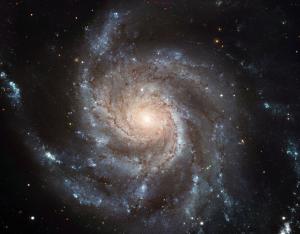FAYETTEVILLE, Ark., Aug. 11 (UPI) — The Milky Way is one of many disk galaxies with spiral arms, elongated and curved collections of gas and stars that snake outward from a dense galactic center.
New research by a pair of astrophysicists from the University of Arkansas offers support for a long-debated theory for how spiral arms form.
“Spiral galaxies are fascinating structures in astronomy, and the exact mechanism of the formation of spiral arms is still a mystery in astrophysics,” scientist Hamed Pour-Imani said in a news release.
The evidence, detailed this week in the Astrophysical Journal Letters, lends strong support to the density wave theory of spiral galaxies.
The density wave theory posits that spiral arms are not material entities, but shifting areas of congestion. They’re like traffic jams, with stars moving in and out of rush-hour traffic as they orbit the galactic center.
First proposed in the 1960s, the theory suggests the pitch angles of each spiral arm should shift with the wavelength of the galaxy’s image.
Previous analysis failed to identify a correlation between pitch angle and wavelength, but in studying imagery from the NASA Spitzer Space Telescope at two infrared wavelengths, Pour-Imani and research partner Daniel Kennefick identified pitch angles in accordance with density wave theory.

COMMENTS
Please let us know if you're having issues with commenting.